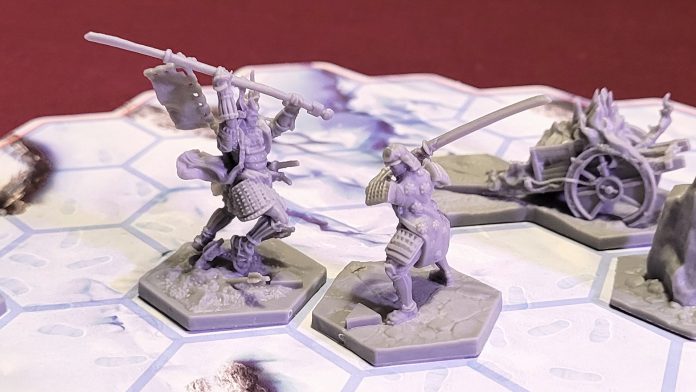Every great samurai movie ends with a one-on-one (or sometimes one-on-many) battle between the hero and the villain, or more often, between the antihero and the other, slightly more villainous antihero. Sometimes they just stare intensely at each other before one makes the decisive killing stroke, but more often, it’s a flurry of movement, strikes, and blocks, before one combatant wears the other one down and emerges victorious.
There is no shortage of great Samurai skirmish games, but I can’t think of any that handle individual combat in detail – it’s usually two miniatures in base contact, with their strikes and blocks decided by a die roll or two. Granted, any more detail than that wouldn’t really be practical when each player is controlling a group of characters, but what about a game that focuses entirely on a one-on-one battle between two samurai?
Senjutsu: Battle for Japan, published by Stone Sword Games and Lucky Duck Games, is here to fill that void. It’s an interesting mix of grid-movement miniatures and customizable card game, with players called upon to create a deck from a pool of (non-collectible, no random boosters) cards representing various attacks, blocks, and other effects such as movement and meditation. Cards are played to move the player’s miniature around on a small, hexagonal gridded board in an attempt to dodge problematic obstacles and get into the right position for that perfect strike.
The Cards
Senjutsu is not a Dominion-style deck building game; rather, each player comes to a match with a preconstructed deck, similar to Magic: the Gathering but without the random packs or collection-building. If deck construction doesn’t appeal, the rule book includes suggested deck lists for each of the game’s four characters. However, customizing your deck and pitting it against your opponent seems to be a major part of the experience as intended by the game’s designers, and chances are that after a few games with the starter decks you’ll want to swap out cards, or even build entirely new decks from scratch.
Each deck represents a single character, with cards depicting that character’s chosen weapons and tactics. Some cards are restricted to specific characters or weapons, while others are more general and can be used in any deck. Additionally, every deck contains two Core cards, usually usable for some combination of movement and attack, which return to the player’s hand after use – players always have access to these two cards, giving them the ability to move or attack regardless of what else they have in their hand.
The game uses two mechanisms to modify when cards can be played and what they do. One is focus, which serves as a currency to pay for more powerful card effects. Focus is gained through various means throughout the game, and can be spent to unlock additional abilities on cards, and is required to play certain cards at all. The other, far more interesting mechanism is kamae, the Japanese word for “stance.”
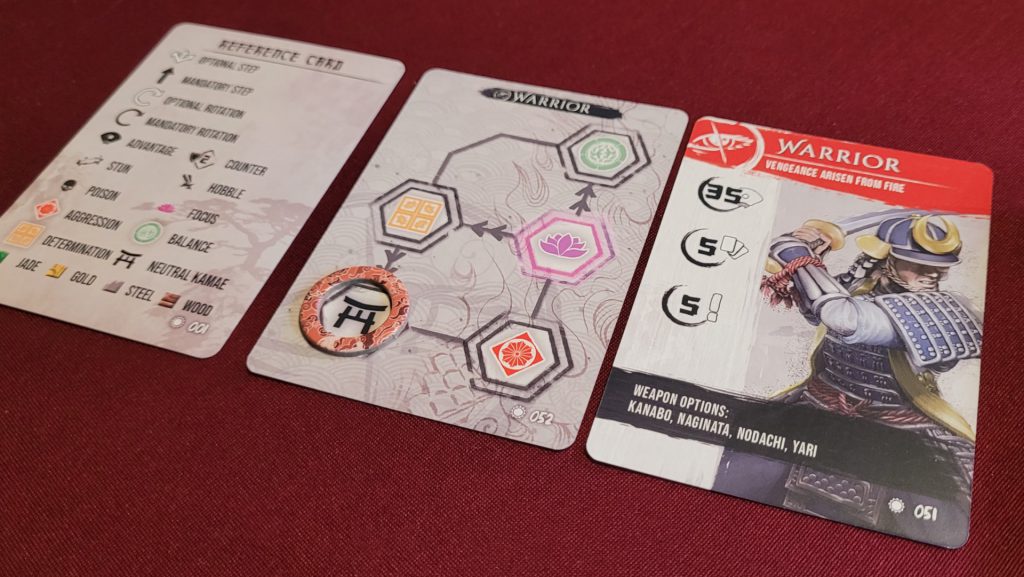
Each of the game’s playable characters has their own unique kamae tree, a card depicting a map of four different stances and the various paths between them. Many cards have different or additional effects depending on whether the character’s stance is aggressive, determined, or balanced, with some cards only playable when in a particular stance. Card effects (including one of the always-available Core cards) will move the character along the paths from one stance to another, so a big part of the game is matching your character’s stance to the cards in your hand that you want to play.
Each player plays one card per turn, chosen and revealed simultaneously. Most of the cards have multiple effects, so a card might allow a move, then an attack, then switch the character’s stance, or it might enable a move in different directions depending on which stance the character is in.
The Board
Senjutsu uses a hexagonal board to play out its battles, less than six inches to a side and only nine inches at its widest point. On first look it seems rather small, but how much space do you really need for a duel between two characters? The game comes with a double-sided board depicting a snow-covered field on one side and a burning village on the other. Also included is a second board that is longer and more narrow, featuring a bridge and a frozen lake.
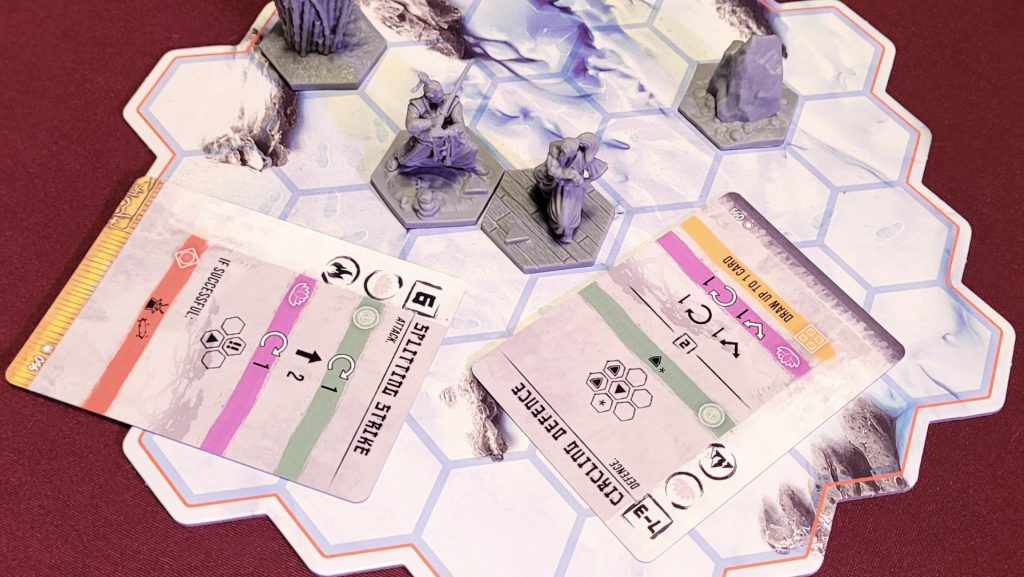
The board’s hexagonal grid is key to moving, attacking and defending in Senjutsu. The miniatures (including terrain features such as rocks, burning carts and bamboo plants) all have hexagonal bases to match the grid, including an arrow to indicate which direction they are facing. Cards that enable movement indicate one or more of six directions, along with distance moved and whether the move is mandatory or optional. Turning to face a different direction is a different but critical type of move that is usually combined with either a movement or attack action.
Cards enable different attack actions, depicted using a grid that shows which hexes the attack will reach relative to the attacker’s position and facing. Blocks work the same way, showing which hexes relative to the defender are defended against. All cards have an initiative value that determines what order they resolve in, so speed is a factor too – if your defense is too slow (or too fast), your opponent’s attack will still get through.
The Miniatures
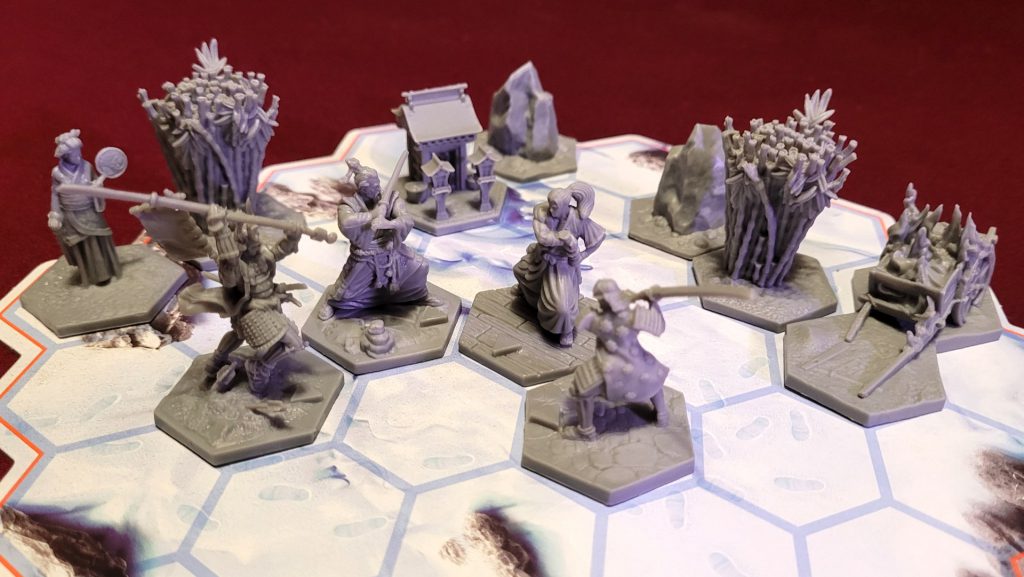
Senjutsu features solid, well-sculpted plastic miniatures – four main characters along with ten terrain pieces and two non-player characters. The scale is around 30mm, but due to the large, purpose built bases, it’s not likely you’ll be using these in your games of Test of Honour or Clash of Katanas. The detail is nice and they look like they’ll take paint well if you are so inclined – I’m considering doing mine all in shades of grey so they look like they’ve stepped out of a Kurosawa film…
The terrain pieces are placed on the board before the start of the game, and serve to break up the board, requiring more thoughtful, tactical movement. They also have consequences if a game effect forces a character to move into or through them. In addition to the plastic pieces like rocks, bamboo and carts, there are a few larger cardboard pieces such as a torii gate and a cherry blossom tree.
A Lone Samurai Wanders Out of the Mist…
In addition to being a robust and well designed head to head dueling game, Senjutsu also includes a multi-part solo campaign, complete with a spiral-bound book that includes several alternate maps scenario-specific rules. There is a short two-player cooperative campaign as well.
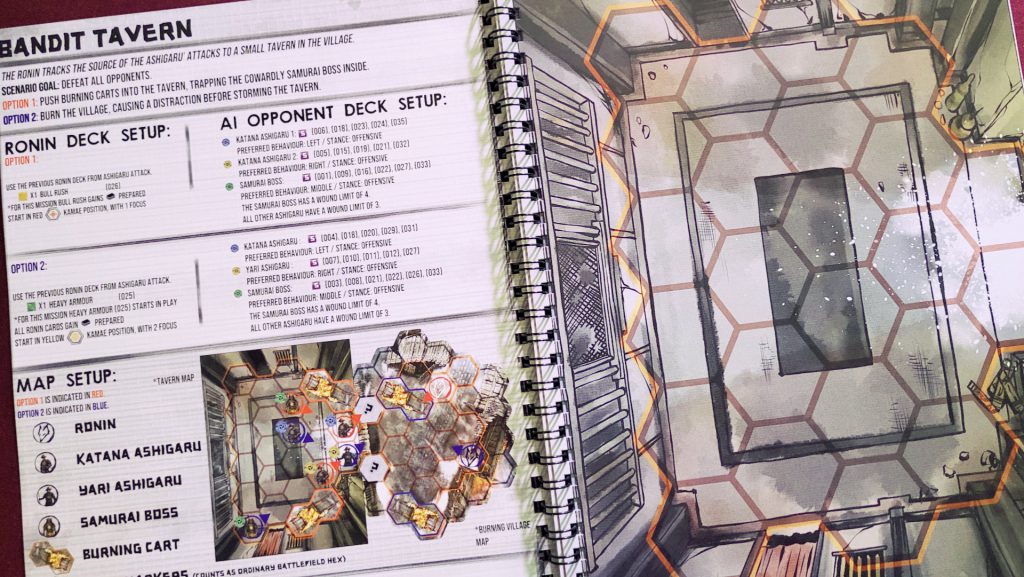
The solo rules also allow for one-on-one duels against any of the playable characters, with guidelines for how to build each non-player character’s deck using a set of cards designed specifically for solo mode.
…Into a Village of Colorful Characters
Moving beyond the core game, there are six Character Pack expansions available, introducing historical personalities like Miyamoto Musashi and Yasuke, the famous African samurai, along with the iconic yojimbo and the ubiquitous ninja. Most of the packs come with two character miniatures, a bit of terrain (or, in one case, a dog), and around 100 new cards to add to the pool for deck building (along with suggested starter decks for each of the new characters.
Conclusions
Senjutsu: Battle for Japan does what it does very well. The card-based game play allows for a level of detail that isn’t practical in games with a larger model count, but it doesn’t get bogged down in too much complication. A limited hand of cards means limited choices each turn, but those choices are still meaningful and interesting, and the need to manipulate kamae and focus adds a bit of resource management into the mix.
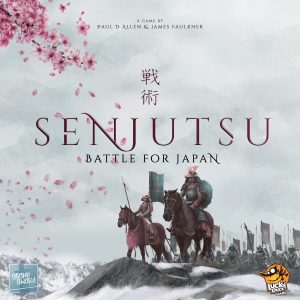
I do think deck construction and customization is a huge part of the game. If that element doesn’t appeal you can certainly play with the suggested starter decks, and probably enjoy the game, but you won’t be getting the most out of it, or the experience I think the designers intended.
With card play being so central to the game, you might ask whether the miniatures are even necessary, but moving the figures around on the board is surprisingly engaging. It involves more meaningful decisions as you will often find yourself agonizing over whether to make a headlong attack or back up and let your opponent come to you. This is what really makes the game feel like a samurai duel, with each fighter inching forward or back until one of them is in the perfect position for that lightning fast, devastating strike.
Have any questions or feedback? Drop us a note in the comments below or email us at contact@goonhammer.com. Want articles like this linked in your inbox every Monday morning? Sign up for our newsletter. And don’t forget that you can support us on Patreon for backer rewards like early video content, Administratum access, an ad-free experience on our website and more.
